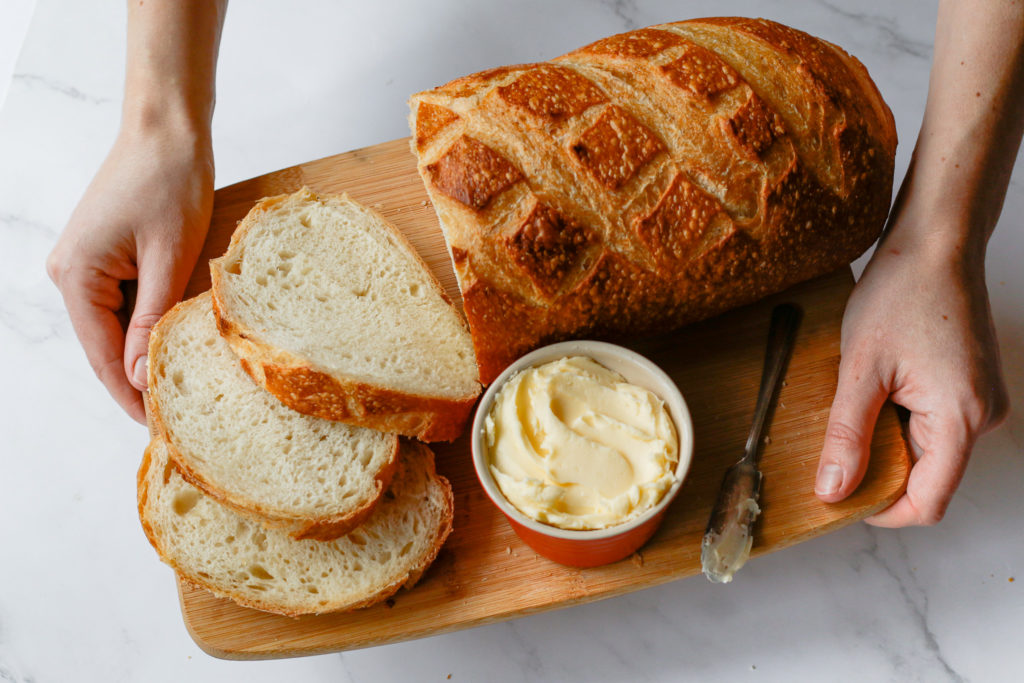How great is butter?
Butter on toast. Butter on potatoes. Butter drizzled on everything from vegetables and meat to bread and popcorn. It’s a staple in baked goods, like buttercream frosting and Canada’s iconic pastry, butter tarts. There’s nothing quite like the taste!
Let’s talk about the different butter types, their uses, and other fun facts about butter.
A short history of butter.
Butter has a rich past around the world.
- The first butter is believed to have been a fluke when, 8000 years ago in ancient Africa, sheep’s milk was jostled on a journey and curdled into a tasty new substance
- Ghee (clarified cow’s milk butter) has been produced in India since around 1500 BC
- Poetry and literature place butter in China’s Tang dynasty, around 618 AD
- Greeks and Romans used butter for cosmetic and medicinal purposes, but it was looked upon as only fit for “barbarians” and peasants to eat until after the Middle Ages
- Yak’s butter sculptures have been crafted by Tibetan Buddhist monks for over 400 years
- Hand-churning became the popular European butter methodology, but in Ireland and other northern regions they made “bog butter” by packing it into small barrels and burying it in peat bogs–sometimes for years–for a strong flavour
- French colonists brought the first dairy cows to Canada in the early 1600s, around the same time they were being introduced in the United States (cattle aren’t native to North America)
- Dairy cows were also on the first colonist ships to Australia in 1788
- The hand-churning method continued in Europe and the colonies until industrialization brought about the first butter churning factories in the 1860s
- Now butter is most commonly made at creameries, although antique butter churns have made a comeback
Types of butter.
With so many delicious butters, it’s hard to pick a favourite.

Salted butter
This is the type of butter that most Canadians are familiar with, because salt was used as a butter preservative by the Europeans. Salted butter contains 2% salt in proportion to its other ingredients.
Unsalted or Sweet Butter
This type of butter is made by the standard method of churning either milk or cream, but without adding salt. It’s the preferred type of butter for baking, because it doesn’t add a salty taste or extra salt that you need to factor into your recipe.
The other key difference is that unsalted butter doesn’t last as long as salted butter, because it’s missing salt’s preservative property.
Cultured butter
This type of butter has healthy bacterial culture–like the kind you find in yogurt–added to the cream before churning. It has a richer, creamier flavour with a hint of tang.
This makes it an ideal choice for cooking, baking, or for simply spreading atop any breakfast food: toast, muffins, bagels, waffles… the list goes on!
Semi-salted butter
This type of butter is just like other regular butters, and contains 1% salt.
The amount of salt in semi-salted butter has to meet Canada’s legal requirements for foods labeled as “lightly salted” or “lower in salt”, so it has to contain 50% less added salt than regular salted butter.
Whipped butter
You can whip either salted or unsalted butter to make this popular accompaniment. Because air has been beaten into it, the butter is softer, has more volume, spreads more easily, and has fewer calories per serving.
Whipped butter can’t be substituted in recipes that call for regular butter.
Light or Low-Fat Butter
This butter is churned with more air and water, and using pasteurized milk. It has less fat and fewer calories than regular butter, and can contain other additives depending on the brand.
Light butter can be used in cooking, but is not recommended for baking because the higher water content will change the texture and consistency of your recipe.
Ghee or Clarified Butter
Ghee is the popular Indian butter that’s literally been around for millenia. Cow’s milk butter is clarified by gently warming it so that the milk solids separate and settle to the bottom, while the fats rise to the top. The fat is what becomes ghee.
Ghee has a longer shelf life than regular butter, can be used for frying because it has a higher smoke point, and it’s lactose-free. If you’ve been served hot butter with lobster at a restaurant, it was clarified butter.
Here’s how to make clarified butter at home.
Specialty or Compound Butter
Herbs and spices are such a perfect complement to dairy products that many brands now produce butters compounded with flavourful ingredients.
You can find specialty butter with garlic, pepper, chives, rosemary, lime, cranberries, and more. If they’re spreadable, they’re a whipped specialty butter.
You can also easily make your own flavoured butter, by softening your favourite salted or unsalted butter and beating new ingredients into it. There are whole Pinterest boards out there dedicated to unique flavoured butter recipes!

Organic vs. Grass Fed Butter
If you’re concerned about tracing the source of your butter, you’re likely curious about organic or grass-fed butter options.
There’s a common misconception that organic milk is the only milk that is free from growth hormones and antibiotics. Growth hormones are not permitted for use in any dairy cows in Canada, whether they are organic or not. Likewise, if antibiotics need to be used to treat a sick cow, that cow’s milk can’t be used for a strict period of time.
Organic dairy in Canada has tight regulations that govern things like feed and pesticides. If a butter is labeled “organic”, the dairy producer must be certified organic and meet those regulations.
The organic label also doesn’t necessarily mean that the cows were grass-fed, although most are fed grass for a portion of the year. “Grass-fed” in Canada means that a beef or dairy cow has been fed at least 75% grass or forage, and the remaining feed is grains and supplements.
Why not 100%? While that number is achievable in other countries that use the grass-fed label, our snowy winters make it impossible for Canadian cows to graze all year long.
The Dairy Farmers of Canada regulate the grass-fed label. You can also read our article to learn more about organic dairy cows.
Tips to Get More Out of Butter.
If you love butter, you’ll want to check out these extra tips:
Keeping Butter Fresh
Butter: Converting Measurements
How to Cream Butter
Making Bread and Butter (lesson plan)
Where to Find BC Butter



